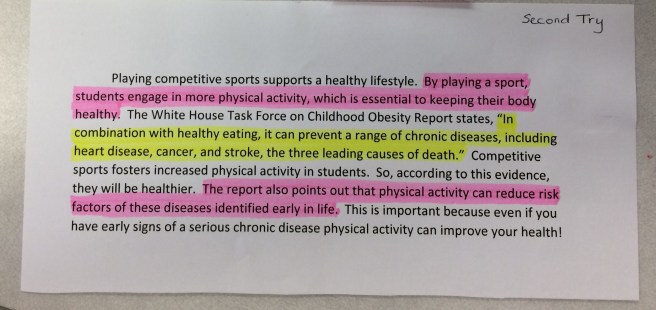This is the last post of this blog series! Phew! It’s been a ride- 8 posts! Each detailing a different strategy for helping students who struggle with adding evidence to their argument writing. Let’s recap what’s been covered so far:
If students quote chunks of text that are too large…
…then use this strategy, Allowing Your Writing to Shine.
If students struggle to cut block quotes because they feel all the information is important…
…then see these two posts on Trimming Down Important Block Quotes by Paraphrasing or Using Ellipses.
If students string together multiple quotes…
…then use one of the String of Quotes strategies that show how to Create Variety or Evaluate Evidence.
If students do not transition in or out of quotes…
…then see the post titled Writers Set Up and Unpack Quotes.
Today’s strategy is the foundation of all the above work. The final strategy I will share is for students who are able to cite a quote, but their evidence is neither pertinent or compelling. Choosing the best evidence to support a claim is imperative in the art of argument, so we must teach students how to select the evidence that best matches their purpose.
When a student uses uncompelling evidence, look at the source materials to discern the student’s logic. More often than not, s/he chose the first reasonable quote found in the source. The student did not postpone the decision of which quote to include until the source material was read. It is important that we teach students to not jump too quickly at the first quote they see. Instead, they should be patient- reading the source material further on the lookout for the BEST quote they can find.
To teach this strategy, I first show students how to read their work with a focus on quotes. As students come to a quote within their piece, I have them reread the quote alongside their reason and ask themselves,
“Does this quote fit my reason? Is there a stronger quote that could support this?”
The answers to these questions help students see whether their quote is sound or if they should look for a better fit.

I model with my own writing how to use sticky flags as placeholders for where a stronger quote could go once further research is done.

Next, I return to the article to read further, mining for stronger quotes that support my claim. I model how to mark, by underlining (or you could use a highlighter), potential quotes as I continue reading down the page. I reinforce to students that sometimes the best quotes are buried deep within the article and that they should not be too quick when choosing a quote.

Once I’ve reread the article and found some other possible quotes, I show students how to choose the best piece of evidence by referring back to this class chart:

Follow up your teacher demonstration with time for students to do the work. Have them reread their piece with a critical eye toward included quotes. If any are weak, they should return to the source material to find a more pertinent quotation to include in their piece. As always, encourage students as they return to independence to keep this strategy in mind. 🙂
I hope that you found this series practical and helpful for your everyday classroom use. Looking forward I would like to share based on what YOU need. So, my next post will be based on the results of the poll below. What are you working on now? Let me know what you would like my next post to be about!
Let’s keep the conversation going-
Lindsay









































